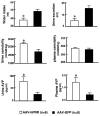Involvement of the brain (pro)renin receptor in cardiovascular homeostasis
- PMID: 20689062
- PMCID: PMC2948614
- DOI: 10.1161/CIRCRESAHA.110.226977
Involvement of the brain (pro)renin receptor in cardiovascular homeostasis
Abstract
Rationale: Despite overwhelming evidence of the importance of brain renin-angiotensin system (RAS), the very existence of intrinsic brain RAS remains controversial.
Objective: To investigate the hypothesis that the brain (pro)renin receptor (PRR) is physiologically important in the brain RAS regulation and cardiovascular functions.
Methods and results: PRR is broadly distributed within neurons of cardiovascular-relevant brain regions. The physiological functions of PRR were studied in the supraoptic nucleus (SON) because this brain region showed greater levels of PRR mRNA in the spontaneously hypertensive rats (SHR) compared with normotensive Wistar-Kyoto (WKY) rats. Adeno-associated virus (AAV)-mediated overexpression of human PRR in the SON of normal rats resulted in increases in plasma and urine vasopressin, and decreases in H(2)O intake and urine output without any effects on mean arterial pressure and heart rate. Knockdown of endogenous PRR by AAV-short hairpin RNA in the SON of SHRs attenuated age-dependent increases in mean arterial pressure and caused a decrease in heart rate and plasma vasopressin. Incubation of neuronal cells in culture with human prorenin and angiotensinogen resulted in increased generation of angiotensin I and II. Furthermore, renin treatment increased phosphorylation of extracellular signal-regulated kinase ½ in neurons from both WKY rats and SHRs; however, the stimulation was 50% greater in the SHR.
Conclusions: The study demonstrates that brain PRR is functional and plays a role in the neural control of cardiovascular functions. This may help resolve a long-held controversy concerning the existence of intrinsic and functional brain RAS.
Figures




Similar articles
-
Nucleus of the solitary tract (pro)renin receptor-mediated antihypertensive effect involves nuclear factor-κB-cytokine signaling in the spontaneously hypertensive rat.Hypertension. 2013 Mar;61(3):622-7. doi: 10.1161/HYPERTENSIONAHA.111.199836. Epub 2013 Jan 14. Hypertension. 2013. PMID: 23319541
-
(Pro)renin receptor knockdown in the paraventricular nucleus of the hypothalamus attenuates hypertension development and AT1 receptor-mediated calcium events.Am J Physiol Heart Circ Physiol. 2019 Jun 1;316(6):H1389-H1405. doi: 10.1152/ajpheart.00780.2018. Epub 2019 Mar 29. Am J Physiol Heart Circ Physiol. 2019. PMID: 30925093 Free PMC article.
-
Training-induced pressure fall in spontaneously hypertensive rats is associated with reduced angiotensinogen mRNA expression within the nucleus tractus solitarii.Hypertension. 2007 Oct;50(4):780-5. doi: 10.1161/HYPERTENSIONAHA.107.094474. Epub 2007 Jul 23. Hypertension. 2007. PMID: 17646572
-
The critical role of the central nervous system (pro)renin receptor in regulating systemic blood pressure.Pharmacol Ther. 2016 Aug;164:126-34. doi: 10.1016/j.pharmthera.2016.04.006. Epub 2016 Apr 23. Pharmacol Ther. 2016. PMID: 27113409 Free PMC article. Review.
-
The prorenin receptor in the cardiovascular system and beyond.Am J Physiol Heart Circ Physiol. 2018 Feb 1;314(2):H139-H145. doi: 10.1152/ajpheart.00373.2017. Epub 2017 Nov 3. Am J Physiol Heart Circ Physiol. 2018. PMID: 29101170 Free PMC article. Review.
Cited by
-
Interaction of central Angiotensin II and estrogen on systolic blood pressure in female DOCA-salt treated rats.Adv Biomed Res. 2016 Apr 21;5:78. doi: 10.4103/2277-9175.180990. eCollection 2016. Adv Biomed Res. 2016. PMID: 27195251 Free PMC article.
-
Acetylation of Aβ42 at Lysine 16 Disrupts Amyloid Formation.ACS Chem Neurosci. 2020 Apr 15;11(8):1178-1191. doi: 10.1021/acschemneuro.0c00069. Epub 2020 Apr 2. ACS Chem Neurosci. 2020. PMID: 32207962 Free PMC article.
-
Defective Wnt Signaling: A Potential Contributor to Cardiometabolic Disease?Diabetes. 2015 Oct;64(10):3342-4. doi: 10.2337/db15-0822. Diabetes. 2015. PMID: 26405272 Free PMC article. No abstract available.
-
Autonomic Dysreflexia in Spinal Cord Injury: Mechanisms and Prospective Therapeutic Targets.Neuroscientist. 2024 Oct;30(5):597-611. doi: 10.1177/10738584231217455. Epub 2023 Dec 12. Neuroscientist. 2024. PMID: 38084412 Free PMC article. Review.
-
The (pro)renin receptor: an emerging player in hypertension and metabolic syndrome.Kidney Int. 2019 May;95(5):1041-1052. doi: 10.1016/j.kint.2018.10.042. Epub 2019 Feb 26. Kidney Int. 2019. PMID: 30819554 Free PMC article. Review.
References
-
- Morimoto S, Cassell MD, Beltz TG, Johnson AK, Davisson RL, Sigmund CD. Elevated blood pressure in transgenic mice with brain-specific expression of human angiotensinogen driven by the glial fibrillary acidic protein promoter. Circ Res. 2001;89:365–372. - PubMed
-
- Lippoldt A, Fuxe K, Luft FC. A view of renin in the brain. J Mol Med. 2001;79:71–73. - PubMed
Publication types
MeSH terms
Substances
Grants and funding
LinkOut - more resources
Full Text Sources
Other Literature Sources

